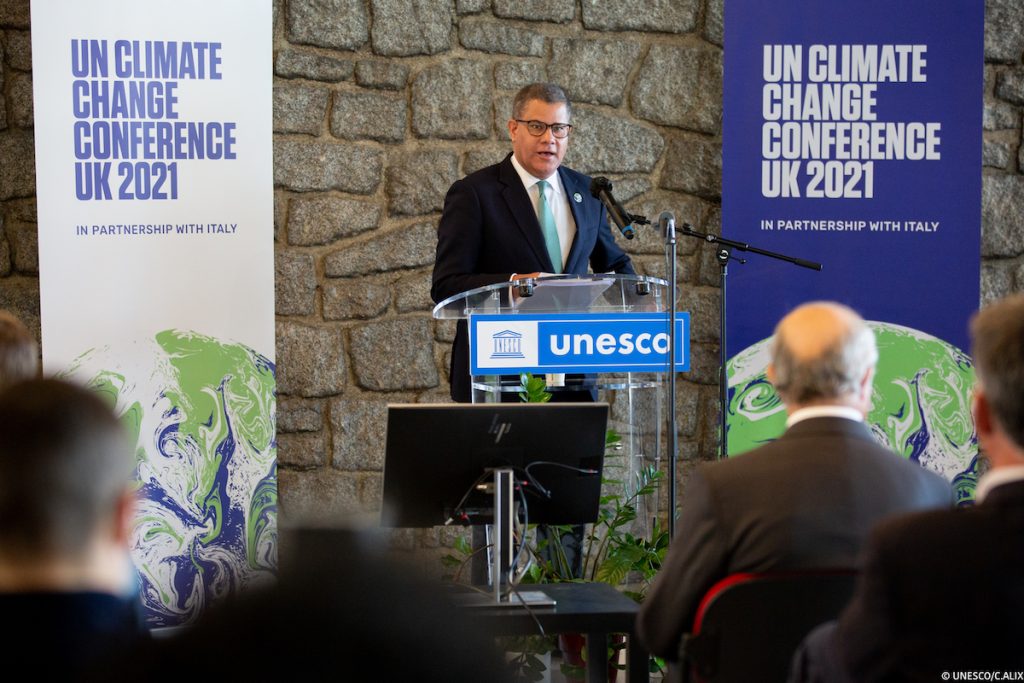
Picture: Alok Sharma, President of COP26. Credit: UNESCO/Christelle ALIX (Creative commons CC BY-NC-ND 2.0).
Monday, October 25. Sydney: The Glasgow Climate Conference of Parties, COP26, is almost certain to fall short of its first goal to “keep 1.5°C within reach”. Moreover, even if it achieved its other aim to “secure global net-zero by mid-century” there is still a high probability that global temperatures will exceed 2°C if this isn’t matched by increased short-term action as well. That’s the message coming from climate scientists from the ARC Centre of Excellence for Climate Extremes (CLEX).
“Our recent briefing note clearly outlines why keeping human-caused global warming below 1.5°C has become infeasible – the lack of deep cuts over the seven years since that target was first announced in Paris in 2015 means we have left it too late,” said Director of the ARC Centre for Climate Extremes, Prof Andy Pitman.
“The likelihood that the remaining carbon budget will give us even a 50:50 chance of limiting warming to 1.5°C is vanishingly small. With our current 2030 climate targets, Australia will have used its fair share of the entire 1.5°C carbon budget by 2027.
“Globally, annual emissions of greenhouse gases have not yet peaked, let alone begun the rapid and sustained decline needed to begin the transition to net-zero. Every year of delay in beginning that transition means we will have to reach net-zero even sooner. Net-zero by 2050 will be too late to limit warming to even 2°C unless emissions are halved this decade.”
While this is bad news, these conclusions do not mean we should give up on the ambition to keep temperatures as low as possible. Every fraction of a degree of extra warming counts. Past CLEX research, and that of many other scientific organisations, has highlighted markedly worse impacts of global temperatures at 2.0°C compared to 1.5°C above pre-industrial temperatures.
Knowing that keeping temperatures below 1.5°C is near-impossible and that staying below 2°C will be a real test of global cooperation, climate change mitigation and adaptation options will undoubtedly be a big part of our future. But the ability to know and adapt to the risks in a future warmer world requires a more comprehensive understanding of what that warmer future brings. One way to begin to clarify the detailed patterns of future climate changes includes an internationally funded super climate model, according to the Royal Society and CLEX researchers, who earlier this year called on governments to contribute to the proposal.
“Today’s climate models are great tools to understand a warmer future at global and continental scales, but our ability to use them to translate this to changes in localised extreme events that create risk for key assets and infrastructure remains limited,” said Monash University CLEX Chief Investigator Prof Christian Jakob.
“COP26’s stated goal to “adapt to protect communities and natural habitats” will require investment in advancing the science and tools we need to understand and predict local weather changes. An internationally funded frontier climate model would be a key piece of infrastructure in that endeavour.”
In Australia, we are already seeing ecosystems and fundamental infrastructure at risk, from globally recognised habitats like the Great Barrier Reef to low-lying coastal townships like those around Gosford NSW and the Gold Coast in Queensland.
These are the known threats, but how storms, floods, bushfires, and cyclones will change in areas where crucial infrastructure presently exists is beyond the current capacity of climate science.
“By 2°C the ice sheet of Western Antarctica will have passed the point where its collapse is unstoppable, committing the world to rapid multi-metre rises in the level of the ocean over coming centuries. Retreat will become the only feasible adaptation option for many low-lying communities here, and for low-lying islands and coasts in Asia and the Pacific this is a catastrophic scenario,” said ANU CLEX Chief Investigator Prof Nerilie Abram.
“And then there are the unknowns. The seemingly unstoppable Black Summer fires occurred when the climate has only warmed by around 1.1°C, yet current commitments made ahead of Glasgow have us on track for a 2.7°C temperature rise, more than double what we have already experienced. We know that climate change is already increasing Australia’s fire risk in multiple ways but have little idea of just how severe Australian fires could become in that climate.”
“COP26 is a key moment in climate negotiations. There is no time left to waste. Glasgow and action in the decade that follows it, will set our future climate path. Further climate warming is inevitable, and we need the scientific foresight to adapt safely to the changes ahead. A super climate model is a critical tool in our fight against human-caused climate change.”
For more information or to arrange an interview with the authors, please contact:
Alvin Stone
Media and Communications Manager
ARC Centre of Excellence for Climate Extremes
Email: alvin.stone@unsw.edu.au. Phone: +61 418 617 366.
